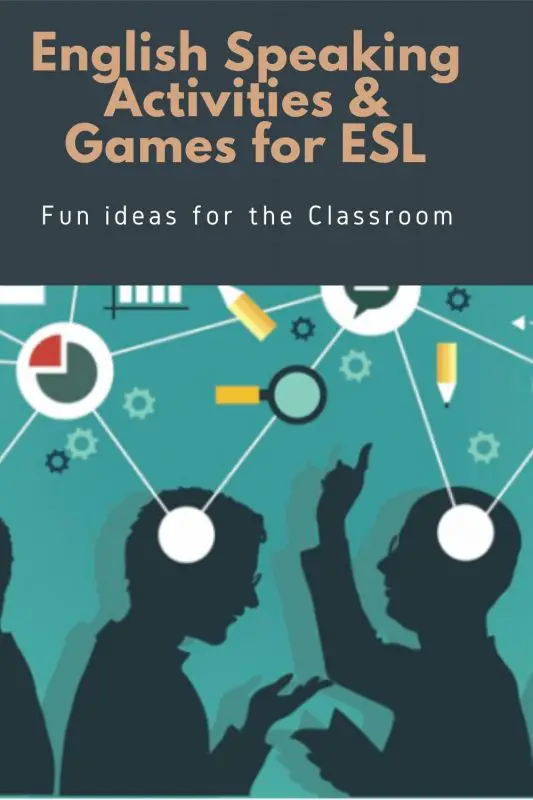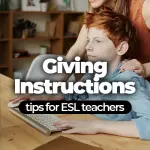If you need some fresh, new ideas for your English conversation class, you’ve come to the right place. I have my favourite, tried and tested ESL speaking activities for adults to try out today. Try out some of these TEFL conversation games today in your ESL class for adults.
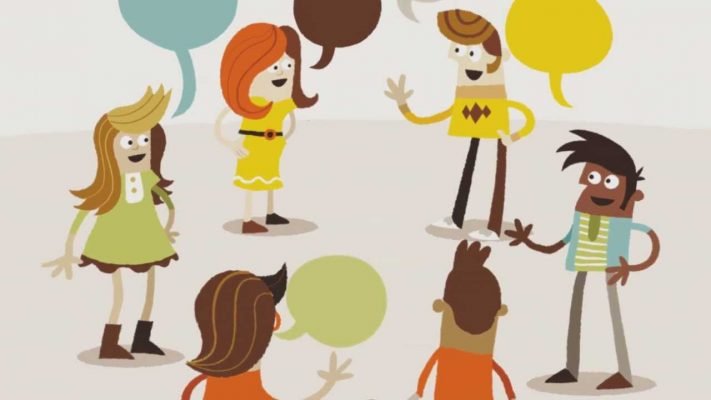
ESL speaking and conversation activities for adults
Let’s get into the best ESOL speaking activities to try out in your classes today. Keep on reading for everything ESL adult activities!
ESL Speaking and Conversation Activities for Adults
I know that my readers are all about the ESL teacher awesome and want to make their classes as interactive, engaging and fun as possible. Who wouldn’t? And I also know that you’re busy doing a ton of stuff and probably don’t have as much time to plan your lessons as you might like.
These best Conversation Games for Adults, all things that I use in my own university classes in South Korea. Most of them can be used for just about any conversation topic, so just adapt and go. Venture outside the world of the textbook, you know? It’s good for your mental health and your students will probably be happier too! Have some fun with these adult ESL activities.
Without further ado, here are the best conversation activities and games for adults if you teach English and need a few ideas. They will help you to reduce teacher talking time in your classes and increase the amount of time your students are doing the hard work!
#1: Running Dictation
This is the ultimate speaking game for adults to get some energy flowing into your class. Even the quietest, most low-level classes will enjoy this one and it’ll get them talking. Monday morning blues? Give this a go. Friday afternoon itch? Try out one of the best ESL conversational games today!
The only pre-requisite for running dictation is that your students are able to read reasonably well. This is definitely the case for all university students in Korea. This one is ideal for monolingual classes because speaking the shared first language doesn’t really give anyone an advantage!
Why I love it so much is that it’s a 4-skills activity and covers a bit of listening, speaking, reading and writing, all in a single activity. You can also customize this activity to almost any level, from high-beginners, to intermediate to advanced. And the challenge is that it requires a huge amount of teamwork to complete the activity.
You can learn more about this classic ESL game here: Running Dictation.
#2: Just a Minute ESOL Speaking Activity
If you ask your students what they want to improve in your class, they often say speaking in English. When you dig a bit deeper, they often mean speaking fluency. That is, being able to talk quickly without a lot of pauses. This is one of the best activities to help them do that!
This is a fun speaking game that encourages your students to just “talk” and not worry so much about using perfect grammar. However, it’s not great for really low-level students though. Just a Minute is definitely one of my favourite ESL speaking games for adults!
A quick tip: choose some popular, perhaps somewhat controversial topics to make this activity more interesting.
Find out how to do this English speaking activity in your class: Just a Minute.
- Amazon Kindle Edition
- Bolen, Jackie (Author)
- English (Publication Language)
- 54 Pages - 11/10/2015 (Publication Date)
#3: Small Talk ESL Game
This is an extremely important, but oft-neglected skill in English conversation classes. Practice it in a really fun way with this challenging game. This conversation activity is one of the best ESL conversation activities for adults.
Check out all the details here about one of the best TEFL conversation activities: Small Talk Speaking Activity ESL.
The key is to tell your students not to worry about mistakes but to focus on speaking fluently.
#4: Role Plays in Conversation Classes for Adults
These are often a staple in ESL or EFL classrooms, especially for beginners and for good reason. They serve as kind of a bridge between learning very basic grammar and vocabulary and then free-talking. Role plays often work best with high-beginner students who are capable of basic conversations if given a bit of thinking time beforehand.
The way it works is that you give students the beginning of a conversation and then they have to continue it with their own words. Or, you could give them the entire conversation, but leave numerous blanks for them to fill it. Adjectives are what I’ll leave blank most often.
Here is some advice about how to set them up and do them well.
Learn about how I use them in my English classes here: Role-Plays for ESL Students.
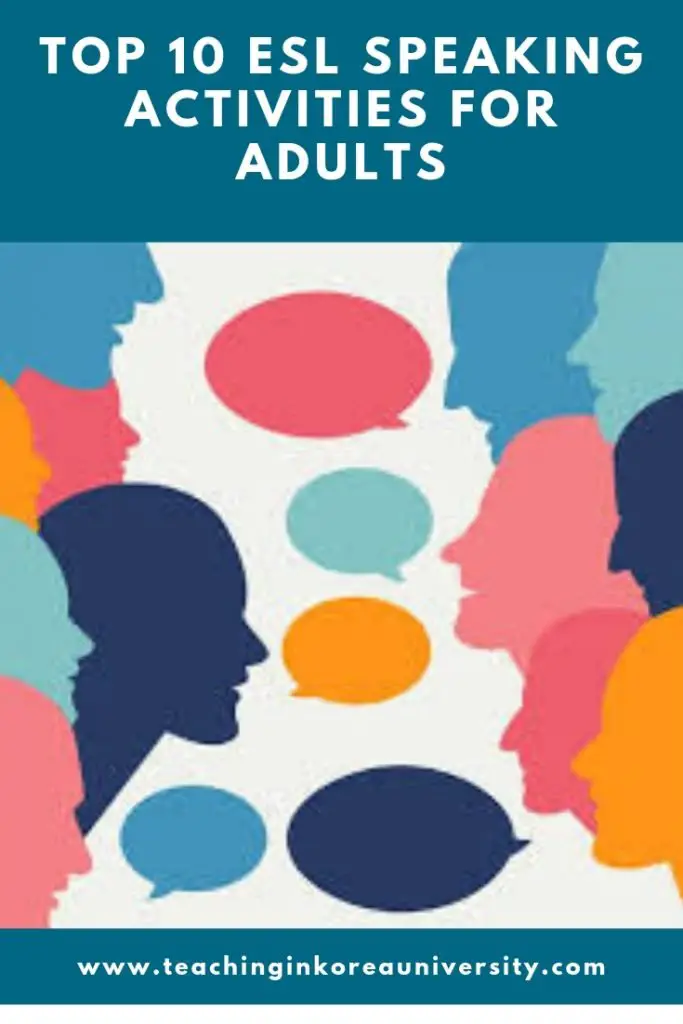
ESL conversation activities for adults
#5: Surveys for ESL Students
If I were going to a deserted island with my students and could only bring one ESL activity with me, this would be it. I LOVE surveys and use them all the time in my classes. They are interesting and fun for the students, can be used for almost any topic, grammar point, or vocabulary set and the questions are easy to make in just a few minutes.
But, perhaps the best thing about ESL surveys? They cover a huge range of skills in a single activity: speaking, listening, reading, writing, grammar and vocabulary. And, they also encourage students to ask follow-up questions.
Okay, so there’s another best thing about them. Students have to get up and move around the room. This is the perfect way to energize a sleepy, tired class.
Here are 6 of them for you! If you’re looking for ESL conversation activities for adults, look no further!
Check out some of my surveys here. It’s one of the best adult ESL activities. 6 ESL Surveys to Try out in your Classes
- Amazon Kindle Edition
- Bolen, Jackie (Author)
- English (Publication Language)
- 94 Pages - 05/30/2015 (Publication Date)
#6: ESL Board Games for Adult Learners (or Kids too!)
Okay, so I kind of lied about the previous thing. I’d likely bring a board game to my deserted island with my students instead of a survey. Ideally, I’d bring both because I use them both all the time.
Board games work especially well as a review activity at the end of a unit of before a test. Or, they lend themselves particularly well to units on problems/advice. The best thing? They work for almost all levels, assuming that the students can read.
Also, if you have a large class, they’re the perfect, student-centred activity. Just put students into groups of 4-5, give them the board and let them play! Teachers should monitor the groups and act as referee in case of disagreement. This is kind of a long activity, so allow at least 15-20 minutes for it in your lesson plan.
Find out more here: Board Games for ESL Students. Sometimes you can find them in the teacher’s resource book that accompanies most textbooks. Or, you can easily write your own in just a few minutes, especially if you have a template to work from. You can also use this with your student during private teaching.
Or, check out this short video for how I like to use board games in my classes. School really can be fun!
#7: Dialogue Substitution
#8: Vocabulary Review Game
Learning vocabulary is all the repetition. Seriously. It’s all about repetition, which is the only way our students will remember new words. Help out your students with this fun review game that helps them come up with new ways of describing certain terms.
Check it out here: English Vocab Review Game.
You can also do a variation of this one with a list of famous people. Students have to describe one of the people, and the listeners have to guess who it is.
#9: Partner Conversation Starters in an ESL Class for Adults
Students generally like to talk to each other, but it won’t go well unless you give them an interesting topic, like would you rather questions, or a reason to talk to each other. Some conversation starters are an excellent way to get things rolling with classroom discussion.
Learn more here: Interesting Partner Conversation Starters.
I generally give students the question of the day and then let them get to it in pairs. At the end of the allotted time, you can elicit some feedback about what was discussed in the groups (or just a few of them for a bigger class).
#10: Rocks-Scissor-Paper TEFL Conversation Game
Do you teach really low-level students? This is a fun speaking game for you. I guarantee that even the lowest of the low level will be able to “get” it. I often use this is a review activity before a test.
Learn more here: A Fun ESOL Speaking Game.
The way it works is that you create sentence matches—question and answer on strips of paper. Then, you cut them out, and give each student 4-5 random papers. They have to mingle with the other students to find their match. It’s simple, but a great way to review grammar and vocabulary.
At the end of the activity, you can explain some of the more difficult answers and it’s an ideal way to remind students of key points before an exam.
#11: Time ESL Speaking and Listening Lesson Plan
One of my favourite ESL speaking activities is to put students into pairs or small groups and then give them an easy-to-follow lesson plan like this one on time. It’s interesting, engaging and will have your students speaking for almost the entire class. Have a look right here at a top pick for TEFL conversation activity:
Time English Conversation Lesson Plan.
#12: Five Senses
Try out this quick warmer activity with your students today:
#13: Picture Prompt ESL Speaking Activities
Okay, one more! This one is too good to leave out. The way it works is that you have to put up a picture (find free pictures online) on the screen at the front of the classroom. Beginners will have to say a word or two of what they see. Or, higher-level students can speak with a partner about what’s happening in the picture.
This activity it much more versatile with intermediate or advanced students. They can make up a story about what’s happening, or what will happen next. Alternatively, it can be used as a writing prompt for a writing class.
You can also try making cards with various pictures and laminating them. Then, each pair or group can get a different one each class, or even choose one that looks most interesting to them.
In particular, one topic that this works well with is Prepositions ESL. Students can talk about where the objects in the picture are in relation to each other.
#14: Job Interview Practice
If you teach university-age students, many of them will be practicing English because they want to do well on a job interview. It’s the case in many countries that students have to do this in English and not their native language. Here are a few tips for helping students with this.
Try to discourage memorizing answers word for word and sentence to sentence. It will always be obvious to the interviewer that this is the case and will make them think that the person doesn’t actually speak English that well.
It can be useful to work on a list of something like the, “20 most popular job interview questions.” But, instead encourage students just to make some brief notes of the things they want to cover. For example, point A, B, and C.
Encourage students to have 4-5 stories that show some of their skills on the top of their heads and well-rehearsed. Things that demonstrate teamwork, overcoming an obstacle, leadership ability, etc. Many interviewers will ask these types of questions. Each story can be used for a variety of questions.
Give lots of feedback to students throughout this process. When a job is possibly on the line, don’t be so kind when it comes to things like mispronouncing a word, or an example of terrible grammar. Point them out (kindly!) to the students so that they can improve.
#15: Dictogloss (Retell the Story in Your Own Words)
This is another classic speaking activity that you may want to try out in your classes. It’s heavy on the listening, and then students can respond with either speaking or writing.
The way it works is that you find a story in your textbook for example, or you can easily write your own papers from scratch. Read the story at a mostly normal pace, and then students have to work together in a group to recreate it to the best of their ability. They will not be able to do this perfectly, but the key is to get the gist of it, or the main ideas.
Then, read it again and students have another try. Finally, you can hear what some of the groups have created, and then compare your version with theirs.
Find out more here about TEFL conversation activities: Dictogloss for TEFL Classes.
- Amazon Kindle Edition
- Bolen, Jackie (Author)
- English (Publication Language)
- 278 Pages - 07/12/2020 (Publication Date)
#16: What about ESL News Articles?
If you’re teaching conversation classes, you (and your students) may get bored of the same old stuff from the textbook. That’s why it can be really interesting to bring some currents events into the classroom.
The only issue is that it can be a bit difficult to find news articles that are at an appropriate level. However, it’s not impossible. Here are some of my go-to resources for an ESL conversation activity: The Best ESL News Article Sites.
#17: Odd One Out
#18: Travel ESL Conversation Lesson
If you’re teaching speaking or conversation, then one thing that’ll save a ton of time is using a ready-made lesson plan like this one on travel. It contains the following:
- Warm-up question
- Vocabulary
- Idioms and phrases
- Conversation questions
- Writing prompts that are ideal for homework.
In short, everything you need to do a speaking lesson for teenagers, university students or adults in style! Have a look here at one of the best things to do in an ESL class for adults: Travel English Conversation Lesson Plan.
#19: 20 Questions for Language Learners
I love it. You love it. We all love it, even English learners. The key is to adapt it a little bit based on the level of the students, and what your goals are.
Try out this engaging ESL activity for adults in your classes today! It’s ideal because it requires no preparation, or materials (paper, pens or books). Keep a few of these in your back pocket for those last-minute classes that you get thrown your way.
Try out this conversational game for adults: 20 Questions for ESL Students.
#20: Seeing Eye to Eye Lesson Plan
A nice way to help students speak more fluently is to work on vocabulary, including expressions, idioms and phrases. Check out one of the lesson plans I put together related to this. It’s a great ESL conversation activity.
English Idioms and Phrases Lesson Plan.
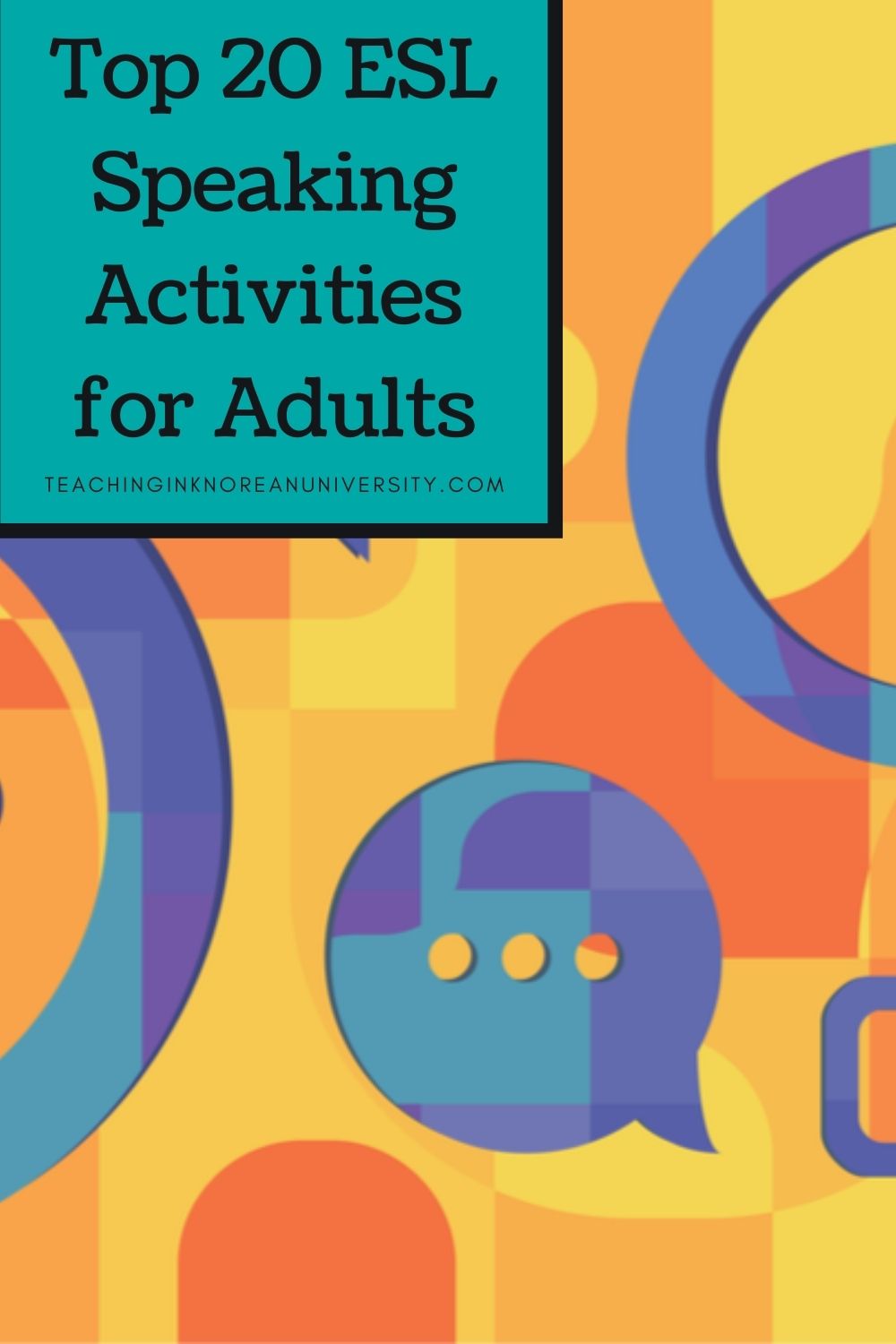
ESL conversation class for adults
#21: Disappearing Text Grammar Review Game
If you’re looking for a quick filler activity at the end up class, try this one. It’s kind of like a little quiz to test how well your students remember the lesson. I’ve used it quite successfully as an ESL preposition activity before.
It can take as little as a couple of minutes and it’s an excellent way to review what you’ve studied that day. You erase the sentence word by word and students have to remember what’s there.
However, it’s only for lower-level students. Disappearing text is one of the best ESL activities for adults who want to brush up on their grammar and vocabulary.
Find out more about this Grammar Review Game:
#22: ESL Group Activities for Adults: Group Therapy ESL Icebreaker
This is a fun ESL activity for adults that is the perfect icebreaker for the first day of class. It’s an interesting way for adults to share what they’re nervous about with regards to studying English.
See how to set-up and use this ESL icebreaker in your classes:
#23: Apples to Apples Vocabulary Game
- Includes more than 1,000 cards, plus tray and instructions
If you’re looking for a “party” game or something to review vocabulary or common words, Apples to Apples is your activity. You can buy the cards on Amazon, or make your own. It works well for a variety of levels, but you’ll have to make different decks to account for this in most cases.
Check out this vocab game for yourself that’s ideal to play in a team:
#24: Draw an Idiom
A quick, simple, fun warm-up is to have students draw some idioms. You’ll usually get some hilarious results, and it’s a perfect lead-in to many different topics.
Find out more about one of the best conversational games for adults here: Idiom ESL Activity.
#25: Picture Quest
Are you looking for a fun activity to do in your classes in order to give your students a break from the regular old textbook grind? Then you’ll want to keep reading all the details for Picture Quest, a fun group activity that gets your students out of the classroom and having fun around their school or university.
When we’ve been working hard in class and students are weary of the studying (like right before finals!), I often give them a break and send them outside on this picture quest ESL activity if the weather is nice.
It’s an excellent way for them to work together as a team and to have a bit of fun in the process. A 16 week semester can be pretty gruelling for the students (and the teacher!).
I generally warn my students in the class before we do this about wearing appropriate shoes! It’s not ideal to be walking all over campus in high heels.
Picture Quest Handout
I give one handout to each team of this paper: Picture Quest. Then I give students 5 minutes to make a plan and send them on their way. The best teams at my university take around 25 minutes and the slowest teams around 40.
The way it works is that students have to take a picture of each thing on the list. To keep it simple, I require that the team only uses 1 phone/camera. When they’re done, they come back and I check to make sure they’ve gotten all the pictures required.
You can give a penalty for missing one, or a mistake. I usually say 5 minutes.
Who is the Winner?
Make note of the rules on the top of the handout! The winning team is the one with the lowest total time (how long it actually took them plus any penalty minutes added in).
Does Picture Quest Work Well for Kids?
I generally only do this with students in high school or university. Think about it this way. Are the students going to be running around the halls of your school, loudly interrupting other classes and teachers?
If the answer to this question is yes, you should probably avoid it. And it’ll almost always be yes with middle school or younger aged students.
Of course, I mention to my students to be respectful when they’re inside and use inside voices, even though they may be excited!
And for elementary school students, it’s certainly an issue of supervision. You’ll be unable to directly keep an eye on more than one group of students. This is probably not allowed by your school policies so consider this carefully.
#26: Chain Spelling
In my opinion, spelling is an important but often overlooked skill in many an English class. That’s why I like to do some practice with it for any new vocabulary words that I teach my students.
One game that I like to play is chain spelling. It works best for beginners rather than more advanced level students. The way it works is that everyone stands up and you say a word. Students have to take turns spelling the word, letter by letter. If they miss a letter, they sit down and are out. The last person left standing is the winner.
#27: Whiteboard Relay Races
There are just so many things that you can do with a whiteboard in language classes! For whatever reason, students, even adults love to write on it. Basically, have two students come up to the board from each team and give them a marker. Then, they have to race to do something. Some possibilities include:
- Writing the answer to a question
- Spelling a word
- Writing the question for a statement you just said
Get creative because there are a million ESL group activities you can do with this.
#28: Speaking Fluency Activity
#29: My World Icebreaker, Teaching Activity for Adults
A quick icebreaker that works well for the beginning of the semester is My World. Students have to draw a circle and then put some simple words, numbers or pictures inside of it, describing themselves. Around 4-5 things are best.
A student may have:
- 21
- Cat drawing
- Mountains
- 5 people and a house
Then, put students into pairs. Their partner would guess that the student is 21, has a pet cat, enjoys hiking, and lives with his mom, dad, grandmother and sister. They can talk a little bit about each of these things. For example, how old is the cat, where they like hiking, etc?
It may be more of a challenge (and also more interesting) if students are from different countries. And remember that the main point is for students to get to know each other a little bit, not to make it too difficult or challenging.
#30: Easter ESL Activities
When teaching just about anyone, I love to include some holiday-themed lessons in my classes. They make a nice change of pace from just powering through the textbook! Here are some of my best ideas for one popular holiday:
Easter ESL Classroom Games and Activities.
#31: A-Z Alphabet Game
#32: Talk Show TEFL Introduction Activity
If you’re looking for a fun, student-centred TEFL introduction/icebreaker activity, then give talk show a try. It’s a nice way for students to get to know each other and they really enjoy it. Have a look:
Talk Show ESL Introduction Activity.
#33: Steal the Eraser TEL Conversation Game
Try out this fun TEFL conversation game to review just about anything! It’s student-centered, engaging and interactive and best of all, the students love it. It’s best for beginners in which you can ask questions that have quite specific answers. Try out this TEFL conversation activity today:
#34: Vocabulary Auction
#35: 2 Truths One Lie ESL
This is one of my favourite ESL Conversation Games for adults. It’s fun, engaging, and student-centred in a big way. Plus, it encourages a ton of interaction and conversation. Find out more about this TEFL conversation activity for adults:
#36: Short Stories about Life in Canada
- Amazon Kindle Edition
- Bolen, Jackie (Author)
- English (Publication Language)
- 112 Pages - 11/01/2021 (Publication Date)
I love to use stories in my classes. However, it can sometimes be a little bit difficult to find interesting ones at an appropriate level. That’s where a book like this one comes in. There are more than 20 interesting and engaging stories about what life in Canada is like, along with questions.
#37: ESL Food and Drink Games and Activities
Who doesn’t like talking about food, right? Have a look here for some of my favourite ideas for this unit:
#38: Have a Debate
I love to have some debates about interesting topics in my classes. The key is choosing something interesting to talk about. Here are some of my favourites:
Fun Controversial Debate Topics.
#39: Games for Students in the Classroom
Want to have some fun in your class? You’ll want to check these out:
Need More Teaching Activities for Adults?
- Amazon Kindle Edition
- Bolen, Jackie (Author)
- English (Publication Language)
- 148 Pages - 03/09/2016 (Publication Date)
Thought so! Then you’ll need to check out this book: 101 ESL Activities for Teenagers and Adults over on Amazon. There are more than 100 ESL adult activities that will make your lesson planning easier, and your students happy!
Dozens of Teaching English to Adults Activities at your Fingertips
The key to a successful class week after week is to add in a variety of activities and games. This book will help you do that in style. Keep a copy on your bookshelf. Or, a copy on your phone for lesson plans on the go. Just open it up and you’ll have a list of dozens of fun ESL games and activities at your fingertips.
Easy to Use ESL Class Activities for Adults
Each activity starts with a brief overview, so you can tell, at a glance what it’s all about. Then, it moves into the step-by-step detailed instructions for how to prepare before class, what to do with the students during class, and then some additional follow-up or feedback. Don’t forget to read the teaching tips too. They’ll help you to avoid the most common mistakes for each activity so that you can have even better classes.
Available in a Variety of Formats
You can get the book in both print and digital formats. The (cheaper) digital one can be read on any device by downloading the free Kindle reading app. It’s easier than ever to have top-quality activities and games for English language learners at your fingertips.
Order your Copy of ESL Activities for Adults Today
Check out the book for yourself today, but only if you want to get yourself a serious dose of ESL teaching awesome in your life, okay?
What’s the Key to Conversation Classes?
If there’s one tip that I can leave you with, it’s this: you shouldn’t actually be talking that much during these types of classes! Strive to make them student-centred.
For example, if I teach a 2-hour class, I’ll talk for probably less than 10 minutes of it. I’ll do a small icebreaker or warm-up, then give a small vocabulary or grammar lesson that usually lasts around 5 minutes or even less. After that, I get students doing a variety of activities to practice. I will give some feedback throughout, but not for long periods of time. It’s easier for me, and also better for the students!
What does this mean for you? The students should be doing most of the talking, with each unless you have a very small class of only 2-3 students. It’s through practice that people improve their speaking skills in another language, so help your students out by designing your classes well! These activities are a very nice start.
- Amazon Kindle Edition
- Bolen, Jackie (Author)
- English (Publication Language)
- 94 Pages - 05/30/2015 (Publication Date)
How do you Teach Speaking Skills to Beginners? Top 10 Tips
When teaching speaking to beginners, here are some of the thing you should consider:
-
- Communication first, fluency and correctness comes later
- Explain activities very clearly
- Allow students to choose topics of interest to them
- Lots of pair and group work
- Change partners often
- Teach speaking and communication strategies (hedging, fillers, etc.)
- Teach vocabulary and basic grammar
- Write examples on the board
- Encourage extensive reading
- Encourage speaking outside of your class
Tips for Teaching a Conversation Class for Adults
If you teach in a university in South Korea (or in many other countries around the world), then chances are you’ve taught A LOT of conversation classes. Here are some of my top tips for making speaking and conversation classes for adults as awesome as possible.
#1: Use a Variety of ESL Speaking Activities
The key to a great conversation class for adults is a variety of interesting, engaging activities. Nobody likes the same old boring thing every single day, right?
So, mix it up a bit and try out something fresh and new to each class. Keep your students on their toes and wondering what you’re going to come up with for them today!
Not sure where to start? This list of ESL speaking activities if a good place to begin. Try out a few of them and your students will probably love them.
#2: Think About Student Talking Time and Design ESL Speaking Activities with this in Mind
Students come to your conversation class because they want to improve their conversation and speaking skills. The best way for them to do this is to practice speaking, a lot.
What does this mean for you as the teacher? Well, you should strive to come up with ESL conversation games and activities that get students talking more, and you talking less!
#3: Break Large Classes up Into Smaller Groups
Think about this: you have 20 students in the class and you go around asking every single person their answer to a certain question. It’ll take up about 10 minutes of class time, depending on the question, yet each student will only speak a couple of sentences.
Or, you could break up students into partners, or groups of 3-4. During this same 10 minute block of time, they’ll speak for at least 2-3 minutes, instead of 20 or 30 seconds. That’s a game-changer!
#4: Ask Students for Feedback
Adults will often have very clear ideas of what sort of conversation activities they want to do. Ask them at the beginning of the course, and also throughout about what they’d like to do! They’ll usually be happy to tell you.
Of course, use your discretion and filter the feedback in order to have the best class possible. You are the teacher after all, right?
#5: Consider Videos for Homework
If you have to assign homework (like in a university course), or the students want homework, it can be a little bit tricky for a speaking class. After all, do you give them a written assignment?
The better plan is to have students make videos. I’ve done this in a variety of ways, from interviewing someone to having a conversation with another person in the class, to just answering a question that I’ve given them solo.
How do you Make an English Conversation Class Interesting?
There are a number of things you can do to make your English conversation class more interesting. Here are a few quick tips:
- Get students to change partners frequently
- Choose a variety of topics
- Get student input for what to talk about
- Use current events
- Offer gentle feedback and encouragement
- Bust free from the textbook!
- Use a variety of games and activities
- Use information gap activities
- Try task-based learning

Fun ESL Activities for Adults
ESL Speaking Activities for Adults FAQs
There are a number of common questions that people have about teaching ESL conversation classes. Here are the answers to some of the most common ones.
What are some of the best ESL activities for adults?
The best ESL activities for adults are ones where students have to interact with each other and also have a reason to speak. The best activities also cover a range of skills at the same time. Try out some information gap activities, surveys, or running dictation.
How do you teach English to beginners adults?
It’s possible to teach English to beginners adults by following a few simple rules:
- Don’t try to teach too many new things at once. A few new vocabulary words or one grammatical point per lesson is enough.
- Repeat and review often.
- Use props and miming as well as realia to make yourself understood.
- Check for understanding using concept checking questions (CCQs) and instruction checking questions (ICQs).
- Use lots of group activities.
- Encouragement!
- Make lessons as student-centred as possible.
How do you make an ESL class for adults fun?
It’s possible to make an ESL class for adults more fun by using a variety of engaging games and activities. Also, be sure to use a variety of different topics and talk about a variety of things from class to class. Include some review sessions and don’t forget to mix up partners so students can talk to lots of different people.
How do you teach ESL adults?
Teaching ESL adults involves using a variety of engaging, interactive and student-centred games and activities that target a variety of skills (reading, writing, listening, and speaking). Use a cohesive lesson plan around a single theme and don’t forget to set the context to help students activate their prior knowledge.
What is a communicative ESL speaking activity?
A communicative ESL speaking activity is one in which English English learners have to speak to other learners and the activity or task will not be able to be completed unless this happens. This requires careful lesson plans in order to create opportunities for communication.
How do you make ESL students speak?
Keep in mind that you can’t force anyone to speak in an ESL conversation class. However, you can create opportunities for English speaking by using well-designed activities such as surveys and games like running dictation in which students will be required to speak to each other in order to complete the task.
How do you Make an English Conversation Class Interesting?
There are a number of things you can do to make your English conversation class more interesting. Here are a few quick tips:
- Get students to change partners frequently.
- Choose a variety of topics.
- Get student input for what to talk about.
- Use current events.
- Offer gentle feedback and encouragement.
- Bust free from the textbook!
- Use a variety of games and activities.
- Use information gap activities.
- Try task-based learning.
What are some strategies for motivating ESL students?
Here are some of my favourite strategies for motivating ESL students, particularly with speaking:
- Choose relevant, interesting topics that pique students’ interest.
- Use a variety of fun and engaging ESL activities and games.
- Change partners often so that students can talk to a variety of people.
- Encourage language learning outside the classroom such as listening to a podcast, or reading a book.
- Make it personal. Never forget to set the context in any ESL lesson.
How do ESL students communicate effectively?
There are a few things ESL students can do to communicate effectively.
- Slow down if you have a tendency to speak very quickly.
- Use clear enunciation and intonation.
- Use body language.
- Be culturally aware.
- Put away the cellphone dictionary and just use words you already know!
- Be human and laugh at any mistakes you make.
- Don’t be afraid of making mistakes.
Did you like these ESL Conversation Activities for Adults?
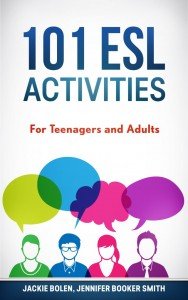 If you liked these fun ESL conversation activities for adults, then you’re going to love this book: 101 ESL Activities for Teenagers and Adults. If you’re looking for interesting, engaging ESL games and activities that are low on the prep and high on the awesome, check out this book on Amazon.
If you liked these fun ESL conversation activities for adults, then you’re going to love this book: 101 ESL Activities for Teenagers and Adults. If you’re looking for interesting, engaging ESL games and activities that are low on the prep and high on the awesome, check out this book on Amazon.
Organized into Sections
The book is well-organized into various sections so you’ll be able to find what you’re looking for easily and quickly. Listening activities? Check. Fun speaking game? There are lots of them. Grammar or vocabulary review. Yes. Warm-up or icebreaker for the first day of class? A ton of them! You’ll be able to make lesson plans in no time.
Available in a Variety of Formats
101 ESL Activities is available in both digital and print formats. Keep a copy on your bookshelf or a quick reference tool. Or, a copy on your phone for lesson planning on the go at your favourite coffee shop.
Easy to Follow Instructions and Activities for these ESL Speaking Activities
The activities are easy to follow and start with a brief overview so you can get the big picture of what it’s all about. Then, you’ll find detailed, step-by-step instructions that show you what to do for preparation before class, what the students are doing in class and then some recommendations for follow-up. Finally, don’t forget the teaching tips that will help you to prevent some of the most common things that can go wrong during that particular activity.
Yes, it really is that easy.
Order your Book of ESL Speaking Activities
You can check out the book for yourself over on Amazon, but only if you want some ESL awesome in your life and don’t forget to share it with a friend:
Have your say about these ESL Speaking Activities for Adults!
What are your thoughts about these ESOL speaking activities for adults? Will they help your students improve their speaking skills? Leave a comment below and let us know what you think. We’d love to hear from you.
And don’t forget to share this on Facebook, Twitter, or Pinterest. It’ll help busy teachers, like yourself, find this useful teaching resource.

ESL group activities for adults
Last update on 2022-06-17 / Affiliate links / Images from Amazon Product Advertising API



